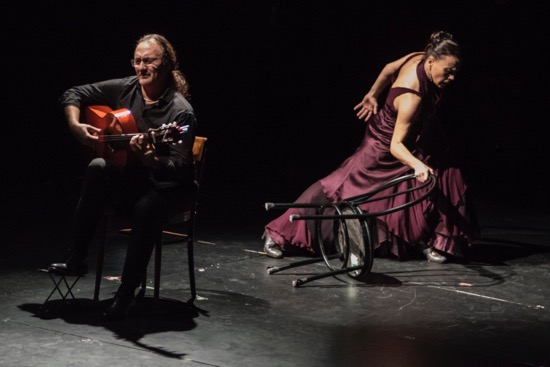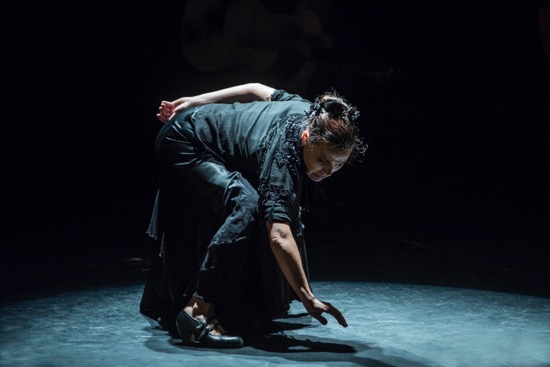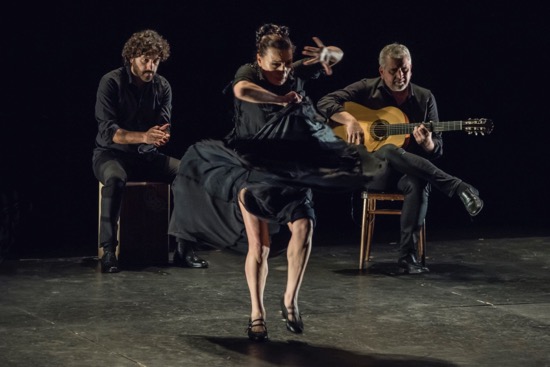Soledad Barrio & Noche Flamenca at the Joyce Theater through February 25th.

Guitarist Salva de Maria and dancer Soledad Barrio in Martin Santangelo’s La Ronde. Photo: Peter Graham
Seeing Soledad Barrio & Noche Flamenca at the Joyce Theater isn’t quite the same as viewing one of the group’s performances at the sweaty little Cherry Lane Theater, where it used to hold its weeks-long seasons. And artistic director Martin Santangelo premiered his 2016 La Ronde at Joe’s Pub. That’s not to say that Intimo, the title of the 2018 Joyce evening featuring La Ronde, is ironic; the dancers and musicians, led by the superb Soledad Barrio, often fix their gaze on us, as if to say, “You too suffer and fight and make love!” The spectators may be less vociferous than those in funkier spaces, but occasional voices cry out, “Anda!” or “murmur “Ole!” as if savoring a satisfying throatful of something powerful. And the evening certainly feels intimate in comparison with the dance-drama Antigona that Noche Flamenca presented two years ago beneath the high-ceilinged theater of the West Park Presbyterian church.
Santangelo put together a very tight show. No intermission breaks its intensity, and the numbers listed in the program leak into one another. An asterisked “subject to change” warns us to be prepared for whatever appears onstage. And whoever. Not everyone connected with the show was born in Madrid, Cadiz, or Barcelona. Think San Francisco. Think New York. Think Texas. Robert Wilson (who played Polyneices in Antigona) is best known as a west-coast hip-hop artist; Hamed Traore, born to West African parents, plays bass as well as guitar. Flamenco itself has roots that snake from India and North Africa.
The costuming is streamlined. Barrio performs her final heart-rending Soleá in a black, form-fitting jacket and a discreetly ruffled black skirt; earlier, she wears black trousers. The only bata de cola that you see is worn by Marina Elana; she switches that long, ruffled, discreetly polka-dotted train out of her way with exuberant expertise. It’s her moment as a butterfly amid all the black, white, gray, and violet garb of most of the ensemble.
Remember La Ronde, the fin-de-siècle Arthur Schnitzler play with its merry-go-round of amorous adventures? One person in each of a series of pairings moves into an erotic encounter with someone else, who then falls for another person, until the prostitute of the first couple reappears. Perhaps you saw the star-studded 1950 French film of it? Santangelo’s couplings are varied in other ways. The piece begins with the guitarists seated along a side edge of the resonant dancing platform, the two male singers standing at the back, and the five dancers sitting close together on chairs lined up and facing sideways. This is our introduction to that quintet—our assurance that they can, in perfect unison, move their hands fluidly and turn their heads sharply to stare at us. Or beyond us with unspoken questions.
The chain lurches slightly when Barrio falls backward over Juan Ogalla’s thigh, and later everyone echoes the outburst with individual ones of their own. Manuel Gago and Emilio Florida begin a rhythmic clapping and then add their haunting, voices. A third singer, Carmina Cortez enters. The dancers cluster to sing with them. The alternation of community and separate desires that Santangelo has orchestrated evaporates, and we’re left with two people and one chair.
Not all the duets are about amorous passion. Barrio’s insistent stamping feet seem to pose questions to superb guitarist Salva de María, and he responds. She flutters her hands; his nimble fingers play to her. She puts her hands over her face, reaches out into . . .what? Dark mysteries. As de Maria goes, Florido enters with his chair and, briefly, sings to her. She leaves the stage, and he has a musical encounter with percussionist David “Chupete” Rodriguez. They face each other to converse—Florido hitting two canes against the floor, Rodriguez slapping the box-shaped cajón on which he sits. The pairings of dancer with dancer or dancer with musician can seem almost accidental, as if the stage were a small town square, even though lighting designer Mark London shifts the atmosphere with subtle theatricality.
Over the course of La Ronde, we see Carlos Menchaca, a tempest of snaking arms and intricately wobbling feet, his shadow thrown on the stage’s brick wall; see Ogalla intervene briefly at some point to dialogue with Rodriguez and his box—prowling the stage, making whiplash turns, and pummeling his rhythms. We watch Elana flourish her ruffled train as she swirls, or grasp it when she buckles down to flurries of stamping; guitarist Iglesias has been countering her patterns, but singer Gago is the one who embraces her, takes charge of her long skirt, and escorts her away. She returns in a simpler dress to dance tenderly with Wilson, not fazed by the fact that he can cast off his upright demeanor to flip over onto one hand and thrust his legs into the air. He literally carries her off.

Soledad Barrio in her Soleá. Photo: Peter Graham
It’s young Menchaca with whom Barrio, now wearing pants too, comes to dance. He’s clearly thrilled, snapping his fingers, matching slow, suddenly punctuated moves with her and bursting into fierce heelwork that brings them together, pulls them apart, and finally unites them. In the end, the erratic chain of events coils and stretches out to refer back to the opening of La Ronde, when we first met these incendiary people.
Only a short blackout confirms the end of La Ronde, and then we’re into three contrasting numbers, in which the performers display their virtuosity and expressiveness. The program identifies a duet for Elana and Menchaca as an Alegrias, while a note renames it Achispar. So, the two, accompanied by guitars and voices, are not just joyful, but a bit tipsy, and resident designer S. Benjamin Farrar backs them with a hint of blue sky. They’re charmingly paired. Menchaca can draw himself up as a proudly erect flamenco expert, but more often, he relaxes his torso and neck slightly, which gives him the look of an eager teenager—one, of course, with marvelously speedy footwork. Elana separates briefly from him to show off confidently, but most of the time, they’re celebrating, delighted with each other.
The program builds to its end by delving more deeply into flamenco’s wellspring of sorrow and defiance, but also into those celebratory moments when dancing is a release from pain. Ogalla performs his Farruca with Iglesias collaborating on guitar. The dance begins as a slow coiling, punctuated by snaps into stillness. Sometime this powerful dancer, feet tightly together, keeps his arms by his sides and his body neutral. What we focus on then are his feet, stamping or trilling against the floor, playing the sound of a heel against that of a toe. Occasionally he drops into a deep lunge or whips himself into a turn. Always his stance is proud, whether he is drawing power up from the ground and through his body to his fluently curling arms, or asserting himself by driving his feet down into that resonant surface.

Soldedad Barrio in her Soleá. Behind her: David “Chupete” Rodriguez (L) and Eugenio Iglesias. Photo: Peter Graham
The singers’ voices—now rough-edged, now soaring; now hoarse, now crystalline—are mingling when Barrio, dressed all in black, enters quietly, slowly drawing one arm up, then the other, so her hands can wreathe around each other in those flamenco gestures that trace feelings on the air. Cortes is there too. So are de Maria and Iglesias, and Rodriguez with his percussion. Barrio may go briefly brow to brow with Florido or advance on Gago, but in this Soleá, she is searching for something less tangible.
Even Federico Garcia Lorca had trouble defining duende. It is a mysterious force, a spirit that, he said in his lecture Juego y Teoria de la Duende, dwells in “las ultimas habitaciones”— the deepest abodes— of the blood. The poet and essayist Edward Hirsch defines the word in his book The Demon and the Angel as “something like artistic inspiration in the presence of death. It has an element of mortal panic and fear. It has the power of wild abandonment.”
You feel all this in Barrio’s Soleá. Her dancing speaks of struggle, of fear, of triumph. When the lights are bright, and she advances swinging her hips, she’s more aggressive than seductive. Sometimes she thrusts and quivers like an arrow seeking its target, but often she forswears conventional beauty— bunching up her skirt as if she just wants to get it out of her way, or squatting down, feet apart. And almost always, her feet are whispering and shouting at the floor, as if there’s an intricate code she hopes it will understand, that she hopes she will understand. But, of course, it’s not really the floor she’s talking to. It’s something darker and more enigmatic. And—watched, helped, and guarded by her colleagues— she makes the hair on the back of your neck stand up.

Beautiful writing Deborah, thank you. “those flamenco gestures that trace feelings on the air”–that resonates with me enormously, triggering a memory of watching those gestures in a smoke-filled bodega in the basement of a hotel in Seville with my father, well-aware that I might not ever do anything like that with him again. Bittersweet, like the form itself: even at its most exuberant there is an undercurrent of impending doom or tragedy or loss.